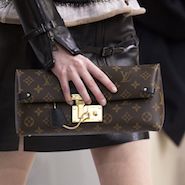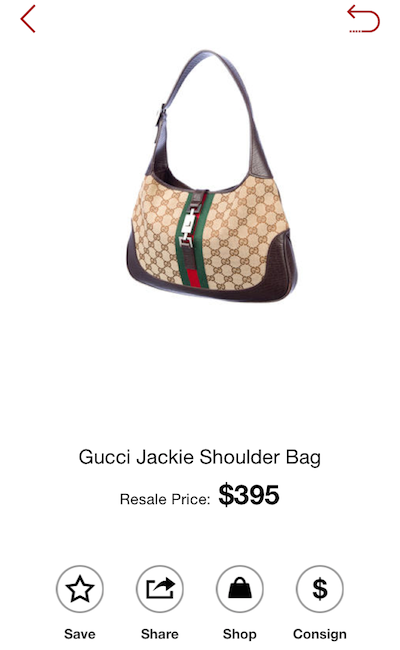 Handbag on Louis Vuitton fall/winter 2015 runway
Handbag on Louis Vuitton fall/winter 2015 runway
Almost a quarter of online shoppers have been duped into buying counterfeit goods, according to a new report by MarkMonitor.
A third of shopping is done online, with that number rising toward two-fifths during the holiday season, and the numbers are projected to accelerate upward in the coming years. As the growth of online shopping coincides with increased access to 3D printing, brands will have to take measures to cut down on counterfeit distribution channels.
"Education around how to identify fakes as well as the risks of buying a cheaper and lower quality product," said Charlie Abrahams, senior vice president of worldwide sales at MarkMonitor. "For example, in electronics - safety and reliability and for clothing – durability and quality.
"We have found that even brands that do not sell online as a policy are subject to counterfeiters filling that void and that brand owners that limit distribution to certain geographies find fakes appearing in the places where the genuine article is not available. Counterfeit sales are is the purest expression of demand," he said.
“Global Consumer Shopping Habits Survey” studied the behavior of 3,450 global consumers. Interviewees came from the United Kingdom, the United States, France, Germany, Italy, Spain, Sweden, the Netherlands and Denmark. Fifty-four percent of respondents were female and 46 percent were male.
Cutting costs
In the UK, online market growth for 2015 is projected to exceed 12 percent, and similarly high numbers are expected in numerous other markets. With the rise of ecommerce channels, however, comes the rise of opportunities for counterfeiters.
Accordingly, 24 percent of consumers have purchased a product online, only for it to turn out to be counterfeit. The numbers are particularly high among young consumers, with 39 percent of 18-34 year olds having done so and 42 percent suggesting they will in the future.
 Gucci shoulder bag
Each year, more than $28.5 billion in profits is lost in the European Union due to counterfeit apparel and accessories (see story).
Although one might expect younger consumers to be savvier with Internet and security, consumers are often drawn to goods that turn out to be counterfeit in an effort to save money. While older consumers with a taste for luxury may have the money to afford high-end brands, aspirational youth who seek the status symbol may be drawn to counterfeit channels.
Gucci shoulder bag
Each year, more than $28.5 billion in profits is lost in the European Union due to counterfeit apparel and accessories (see story).
Although one might expect younger consumers to be savvier with Internet and security, consumers are often drawn to goods that turn out to be counterfeit in an effort to save money. While older consumers with a taste for luxury may have the money to afford high-end brands, aspirational youth who seek the status symbol may be drawn to counterfeit channels.
 Hublot watch
Counterfeiters are getting better at developing Web sites, making it harder for many consumers to detect a fake. Counterfeit emails, however, are more recognizable to consumers.
Sixty-four percent of global consumers are concerned about online security, but less than half know how to check a site certificate and one-quarter said they have no idea how to assess the validity of a Web site.
Perhaps most alarmingly, 5 percent of consumers said that they have found themselves on a site selling fake products but knowingly continued with the purchase. Apparel and footwear, luggage and electronics were the products of which consumers were most likely to knowingly purchase knock-offs.
Hublot watch
Counterfeiters are getting better at developing Web sites, making it harder for many consumers to detect a fake. Counterfeit emails, however, are more recognizable to consumers.
Sixty-four percent of global consumers are concerned about online security, but less than half know how to check a site certificate and one-quarter said they have no idea how to assess the validity of a Web site.
Perhaps most alarmingly, 5 percent of consumers said that they have found themselves on a site selling fake products but knowingly continued with the purchase. Apparel and footwear, luggage and electronics were the products of which consumers were most likely to knowingly purchase knock-offs.
 Prada women's sunglasses
Interestingly, this behavior varied wildly by country. No German interviewees knowingly bought a counterfeit product, but on the other end of the spectrum 35 percent of Dutch consumers continued to a make a purchase when they knew the site was selling fakes. Twenty-five percent of UK consumers, 21 percent of U.S. consumers, 13 percent of French consumers, and 11 percent of Italian consumers proceeded with the purchase.
When consumers were asked what stopped them from purchasing counterfeit products, the most cited reasons were a preference for the real thing (64 percent) and morality (48 percent). Brand loyalty was not a major reason, with only 12 percent of consumers from the study considering it.
Given the costs of counterfeiting to a brand, both financially and in image, it may be in the best interest for a brand to try to educate consumers to recognize counterfeiting or provide measures to work around it. One other potential way would be for a brand to authorize a secondary market for aspirational consumers to buy used goods, similar to a recent Vestiaire Collective community (see story).
Although the democracy of the Internet makes it difficult to prevent counterfeit Web sites from appearing, such initiatives may provide alternatives that appeal to the penny-pinching aspirational.
Keeping honest
In another warning sign for brands, consumers have the highest confidence when shopping on laptops and tablets while marks are significantly lower for mobile shopping, smartphone applications and social media. With mobile shopping poised to become a major sales channel in the near future, brands should take part in helping consumers recognize fakes.
Prada women's sunglasses
Interestingly, this behavior varied wildly by country. No German interviewees knowingly bought a counterfeit product, but on the other end of the spectrum 35 percent of Dutch consumers continued to a make a purchase when they knew the site was selling fakes. Twenty-five percent of UK consumers, 21 percent of U.S. consumers, 13 percent of French consumers, and 11 percent of Italian consumers proceeded with the purchase.
When consumers were asked what stopped them from purchasing counterfeit products, the most cited reasons were a preference for the real thing (64 percent) and morality (48 percent). Brand loyalty was not a major reason, with only 12 percent of consumers from the study considering it.
Given the costs of counterfeiting to a brand, both financially and in image, it may be in the best interest for a brand to try to educate consumers to recognize counterfeiting or provide measures to work around it. One other potential way would be for a brand to authorize a secondary market for aspirational consumers to buy used goods, similar to a recent Vestiaire Collective community (see story).
Although the democracy of the Internet makes it difficult to prevent counterfeit Web sites from appearing, such initiatives may provide alternatives that appeal to the penny-pinching aspirational.
Keeping honest
In another warning sign for brands, consumers have the highest confidence when shopping on laptops and tablets while marks are significantly lower for mobile shopping, smartphone applications and social media. With mobile shopping poised to become a major sales channel in the near future, brands should take part in helping consumers recognize fakes.
 Hermes handbag
Mobile commerce transactions are expected to top $115 billion in 2015 and climb to $142 billion next year, according to a recent report from Forrester Research.
The numbers in the report, “U.S. Mobile Phone And Tablet Commerce Forecast, 2015 to 2020,” point to the ongoing challenge driving conversions on mobile, with nearly one-third of retailers’ Web traffic coming from phones but only 11 percent of sales. However, only a few merchants are truly leading the way in mcommerce (see story).
Although counterfeiting has gained steam in some markets (see story), measures are being taken both within the industry and legally to fight off the practice.
British apparel and accessories brand Belstaff recently won a lawsuit that resulted in the closure of more than 650 counterfeit Web sites.
Heard by a United States civil court, the judges ordered offending counterfeiters to pay more than $42 million in damages and turn over domain names to Belstaff. While this is only the most recent victory in the ongoing battle against counterfeiting, Belstaff’s strategy to combat the issue through digital protection tactics will offer an effective solution for both luxury and mass brands facing a similar predicament (see story).
Through counterfeiting, governments lose out on tax money and luxury brands, often the main target of counterfeiters, must cope with the possible dilution of standing and erosion of trust held by the consumer due to fears of purchasing an unauthenticated product. NetNames, a firm specializing in online brand protection and anti-counterfeiting services, works with luxury brands to protect their online presence and intellectual property from counterfeiting threats (see story).
For brands that rely on storied indicators such as a tweed pattern or specific watch bezels, 3D printing has added another layer to counterfeiting woes.
Hermes handbag
Mobile commerce transactions are expected to top $115 billion in 2015 and climb to $142 billion next year, according to a recent report from Forrester Research.
The numbers in the report, “U.S. Mobile Phone And Tablet Commerce Forecast, 2015 to 2020,” point to the ongoing challenge driving conversions on mobile, with nearly one-third of retailers’ Web traffic coming from phones but only 11 percent of sales. However, only a few merchants are truly leading the way in mcommerce (see story).
Although counterfeiting has gained steam in some markets (see story), measures are being taken both within the industry and legally to fight off the practice.
British apparel and accessories brand Belstaff recently won a lawsuit that resulted in the closure of more than 650 counterfeit Web sites.
Heard by a United States civil court, the judges ordered offending counterfeiters to pay more than $42 million in damages and turn over domain names to Belstaff. While this is only the most recent victory in the ongoing battle against counterfeiting, Belstaff’s strategy to combat the issue through digital protection tactics will offer an effective solution for both luxury and mass brands facing a similar predicament (see story).
Through counterfeiting, governments lose out on tax money and luxury brands, often the main target of counterfeiters, must cope with the possible dilution of standing and erosion of trust held by the consumer due to fears of purchasing an unauthenticated product. NetNames, a firm specializing in online brand protection and anti-counterfeiting services, works with luxury brands to protect their online presence and intellectual property from counterfeiting threats (see story).
For brands that rely on storied indicators such as a tweed pattern or specific watch bezels, 3D printing has added another layer to counterfeiting woes.
"Three-dimensional printing is a subject of great interest to those who seek to protect IP," Mr. Abrahams said. "The ability to recreate a product or component easily and quickly will push the boundaries of IP law and increase the risk of credible counterfeits."
Final Take Forrest Cardamenis, editorial assistant on Luxury Daily